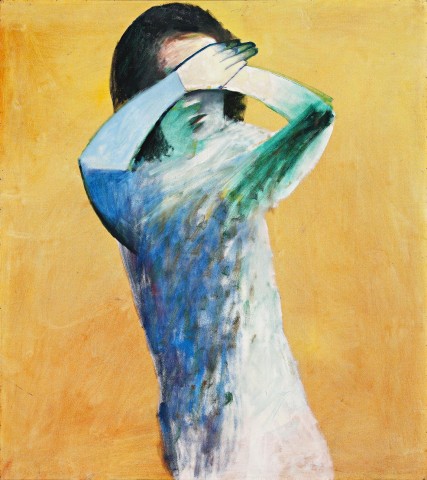GIRL HIDING, c.1967 – 68
CHARLES BLACKMAN
oil on composition board
136.0 x 120.5 cm
signed lower right: BLACKMAN
Halifax Hayes, New South Wales, a gift from the artist
Thence by descent
Private collection, New South Wales
In 1966, Charles Blackman returned to Australia after five years in London, a period marked by critical acclaim and increasingly popular success. Following short stays in Melbourne and Brisbane, the Blackmans settled in Sydney at Attunga Avenue, a narrow, steeply inclined road that bisects the genteel suburb of Woollahra. Rich with vegetation – and wealth – it is conveniently located close to numerous schools, beaches and the city, with the harbour a short walk away. In short, it was a perfect location for the family to re-establish themselves. Their house (at number 12) is near the crest of the hill with expansive views over the area and Blackman soon set himself the task of building his dream studio. Girl Hiding, c.1967 – 68, is intimately tied to the location, having been gifted to Halifax Hayes, a master builder, stonemason and sculptor who assisted Blackman with the renovations at Attunga Avenue and continued as his collaborator on numerous diverse projects over the next decades.
As the artist’s wife Barbara noted, ‘When we returned to Australia in 1966, Charles was famous. Collectors all wanted Blackmans, dealers wanted pictures to sell, galleries wanted shows. We got caught up in the high life: parties, media, photographs’.1 Whilst Charles set about building the studio with Halifax Hayes, Barbara, a noted poet in her own right, turned ‘the new sitting room opening onto the courtyard garden into a venue for dinner parties, musical events, poetry readings and theatrical performances’.2 Attunga Avenue thus became a home full of creative enterprise and their son, Auguste, recalls that Girl Hiding was one of the first paintings his father painted there, and may be interpreted as his direct response to the unique light of Sydney following five years of English skies.3 Not surprisingly, the girl is shown shielding her eyes from the glare, surrounded as she is by the warmth of sunshine yellow; but this gesture characteristically echoes many of Blackman’s other signature paintings, where his protagonists shield their identity from outsiders and inhabit their own world of inner thoughts. ‘Charles' formidable and sensitive understanding of the complex feminine psyche, the tender, human fragility and the potent mythic qualities of the underworld, are touched upon and culminate in this painting. She is vulnerable, but she is not weak. She is casting a spell of her own making’.4 The rapid gestural marks delineating the body further emphasise the girl’s quick movements as if she has just become aware of observers and attempts to block them from her view. Intriguingly, Blackman chose to paint on the reverse, toothed side of the board and the textural pattern provides an optical ‘hum’, not dissimilar to the Op Art movement which had risen in prominence in London during the artist’s last years there. As ever, Blackman found a way to synthesise his individualistic figurative motifs within the aesthetics of otherwise contemporary art movements.
Considering the painting’s personal connection, it is not surprising that Girl Hiding remained with Halifax Hayes for the remainder of his life, a vivid yet intimate talisman of his enduring creative friendship with one of Australia’s most successful and beloved artists.
1. Barbara Blackman, 2010, quoted in Hawley, J., ‘Charles Blackman’, Artists in Conversation, Slattery Media, Melbourne, 2012, p. 280
2. Moore, F. St. J., Charles Blackman: Schoolgirls and Angels, National Gallery of Victoria, Melbourne, 1993, p. 23
3. Auguste Blackman, correspondence with Deutscher and Hackett, September 2018
4. Auguste Blackman, op cit.
ANDREW GAYNOR
